Abstract
The prevalence of overweight at ages 7 and 11 years and in late adolescence was compared in two nationally representative cohorts of British children born in 1946 and 1958. Overweight was defined as weight that exceeded the standard weight for height, age, and sex by more than 20% (relative weight greater than 120%). The prevalence of overweight among 7 year olds born in 1958 was nearly twice that among those born in 1946. Changes in infant feeding practices, food supply, and level of physical activity might be responsible for this difference. By adolescence the prevalence of obesity in both cohorts had increased but the difference between cohorts had almost disappeared. Around 9% of adolescent girls and 7% of adolescent boys were overweight. If infant feeding practices have an influence on prevalence of overweight at 7 years the data from the two cohorts suggest that such an effect does not persist. In neither cohort was there a significant relation between the prevalence of obesity and social class in boys, but in girls the prevalence was higher among those from the lower socioeconomic groups. Correlation coefficients showing the strength of the relation between relative weights at different ages were remarkably similar for both cohorts. The risk of being obese later in childhood for those who had not been obese at the age of 7 was less than one in 10, whereas for those with a relative weight greater than 130% the risk exceeded six in 10.
Full text
PDF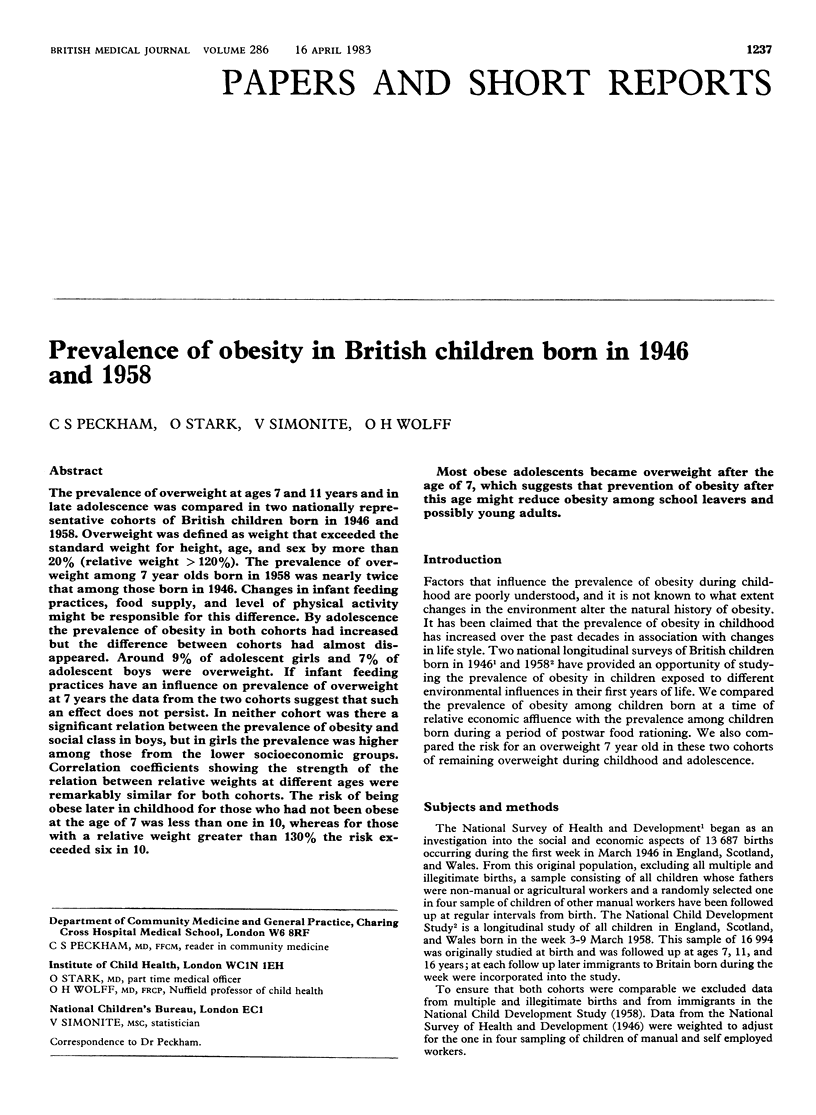

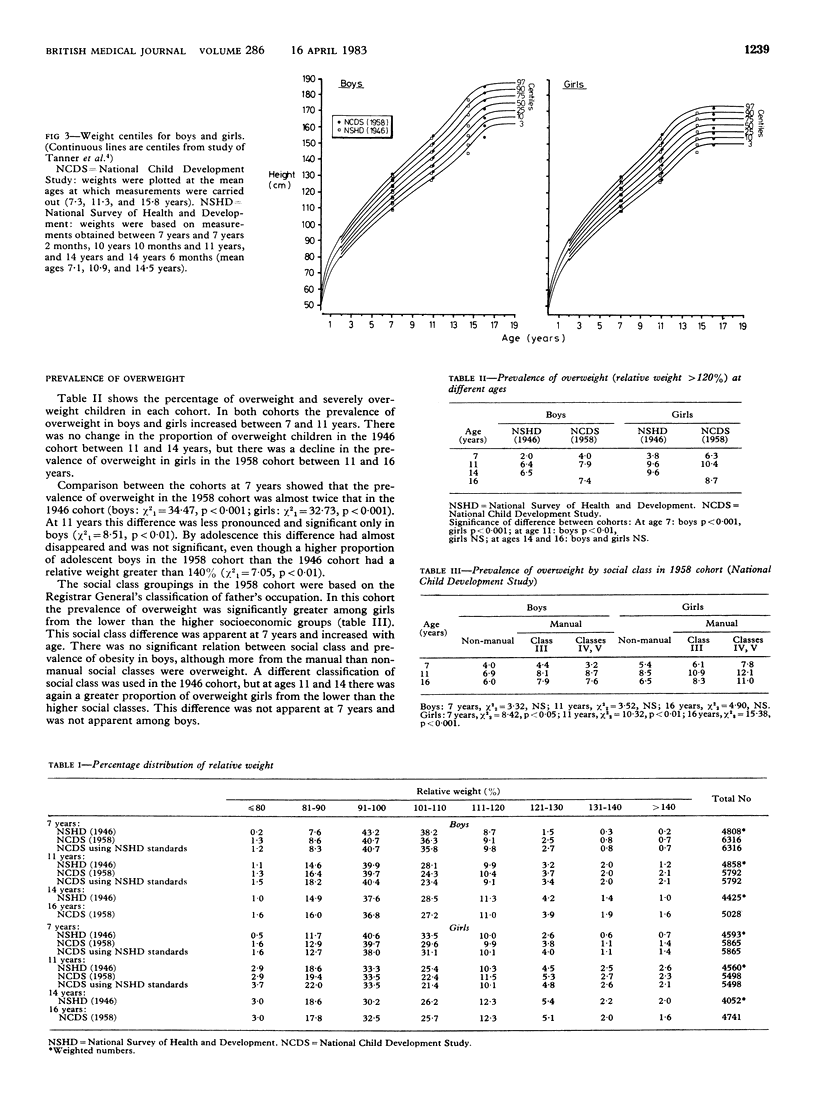
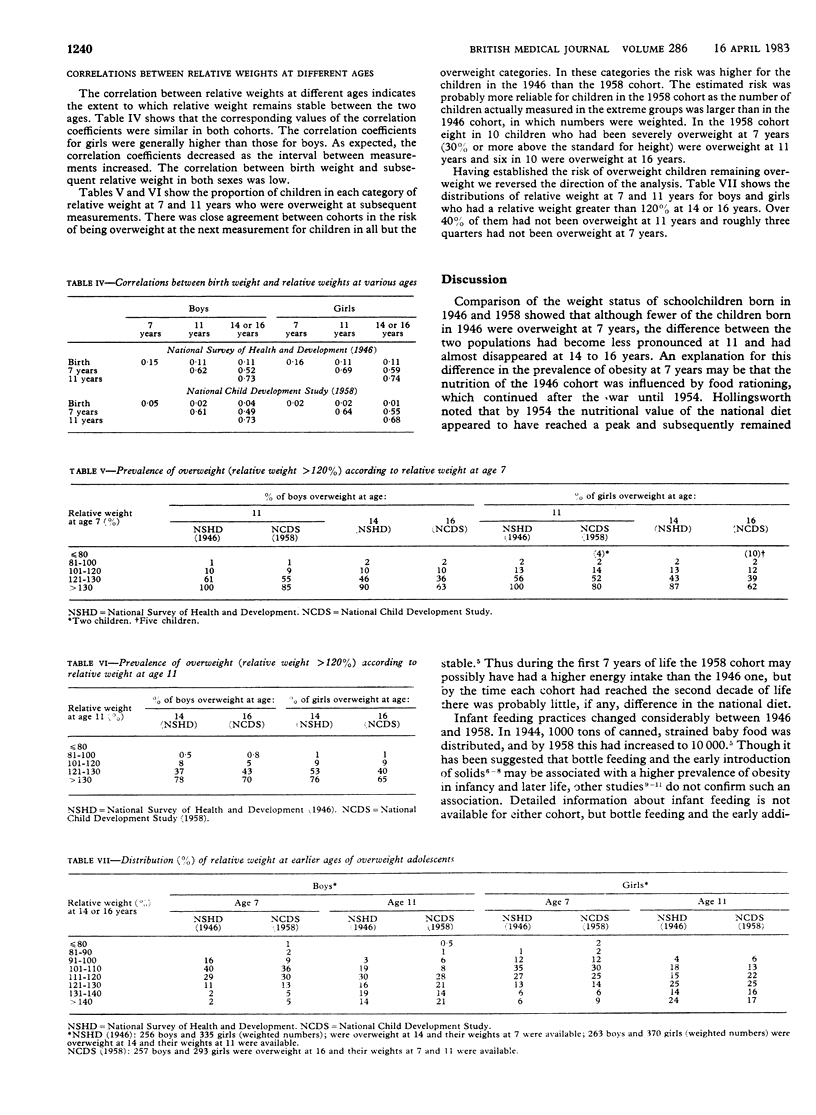
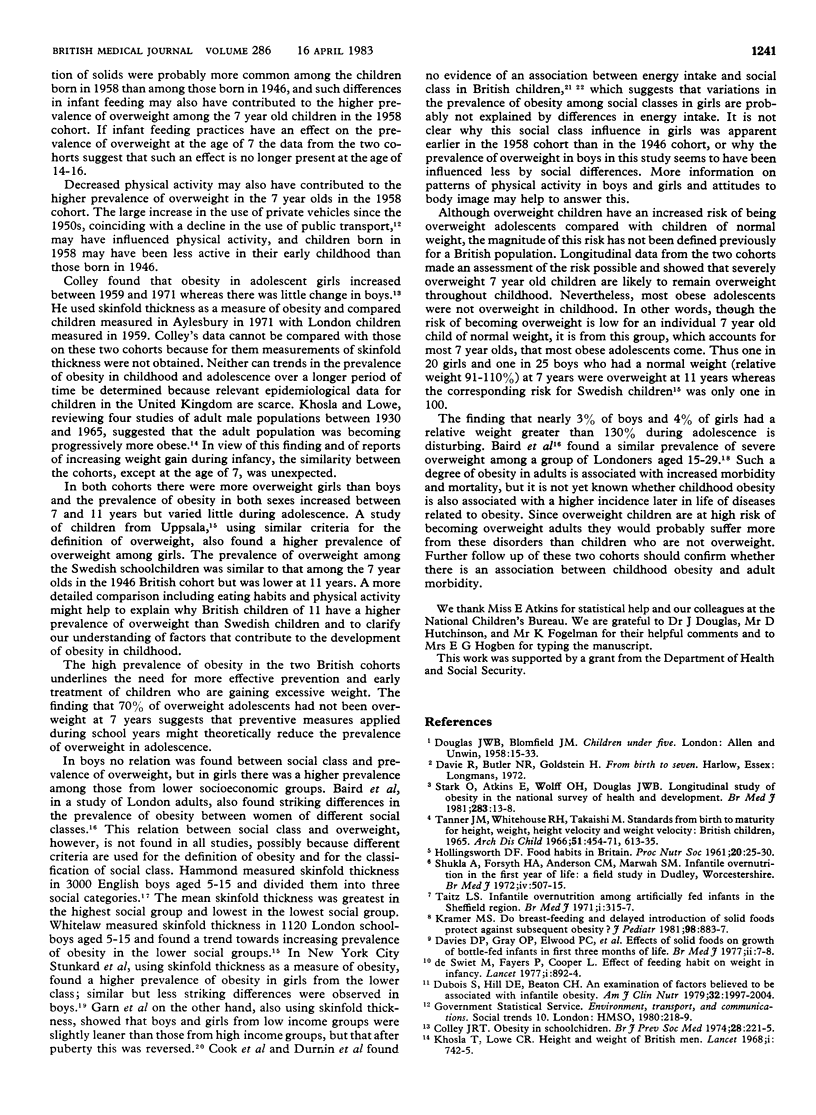
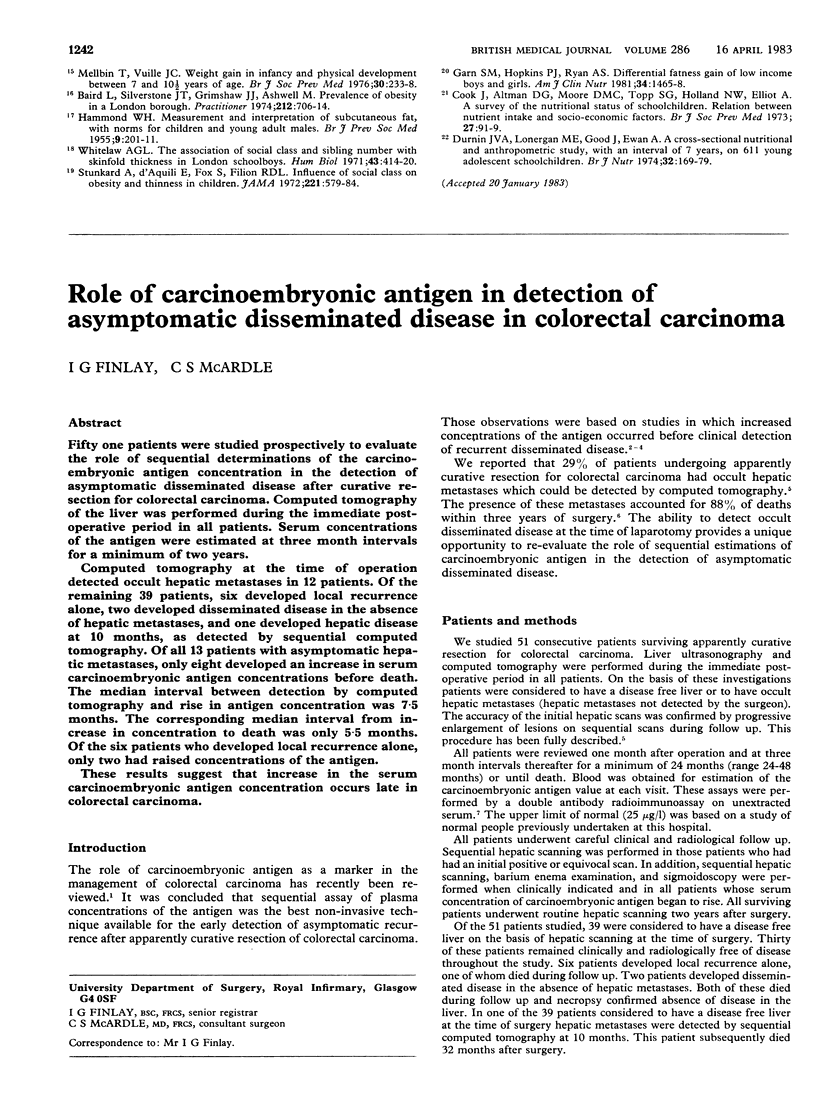
Selected References
These references are in PubMed. This may not be the complete list of references from this article.
- Baird I. M., Silverstone J. T., Grimshaw J. J., Ashwell M. Prevalance of obesity in a London borough. Practitioner. 1974 May;212(1271):706–714. [PubMed] [Google Scholar]
- Colley J. R. Obesity in schoolchildren. Br J Prev Soc Med. 1974 Nov;28(4):221–225. doi: 10.1136/jech.28.4.221. [DOI] [PMC free article] [PubMed] [Google Scholar]
- Cook J., Altman D. G., Moore M. C., Topp S. G., Holland W. W., Elliott A. A survey of the nutritional status of schoolchildren. Relation between nutrient intake and socio-economic factors. Br J Prev Soc Med. 1973 May;27(2):91–99. doi: 10.1136/jech.27.2.91. [DOI] [PMC free article] [PubMed] [Google Scholar]
- Davies D. P., Gray O. P., Elwood P. C., Hopkinson C., Smith S. Effects of solid foods on growth of bottle-fed infants in first three months of life. Br Med J. 1977 Jul 2;2(6078):7–8. doi: 10.1136/bmj.2.6078.7. [DOI] [PMC free article] [PubMed] [Google Scholar]
- Dubois S., Hill D. E., Beaton G. H. An examination of factors believed to be associated with infantile obesity. Am J Clin Nutr. 1979 Oct;32(10):1997–2004. doi: 10.1093/ajcn/32.10.1997. [DOI] [PubMed] [Google Scholar]
- Durnin J. V., Lonergan M. E., Good J., Ewan A. A cross-sectional nutritional and anthropometric study, with an interval of 7 years, on 611 young adolescent schoolchildren. Br J Nutr. 1974 Jul;32(1):169–179. doi: 10.1079/bjn19740067. [DOI] [PubMed] [Google Scholar]
- Garn S. M., Hopkins P. J., Ryan A. S. Differential fatness gain of low income boys and girls. Am J Clin Nutr. 1981 Aug;34(8):1465–1468. doi: 10.1093/ajcn/34.8.1465. [DOI] [PubMed] [Google Scholar]
- HAMMOND W. H. Measurement and interpretation of subcutaneous fat, with norms for children and young adult males. Br J Prev Soc Med. 1955 Oct;9(4):201–211. doi: 10.1136/jech.9.4.201. [DOI] [PMC free article] [PubMed] [Google Scholar]
- HOLLINGSWORTH D. F. The changing patterns in British food habits since the 1939-45 war. Proc Nutr Soc. 1961;20:25–30. doi: 10.1079/pns19610008. [DOI] [PubMed] [Google Scholar]
- Khosla T., Lowe C. R. Height and weight of British men. Lancet. 1968 Apr 6;1(7545):742–745. doi: 10.1016/s0140-6736(68)92183-1. [DOI] [PubMed] [Google Scholar]
- Kramer M. S. Do breast-feeding and delayed introduction of solid foods protect against subsequent obesity? J Pediatr. 1981 Jun;98(6):883–887. doi: 10.1016/s0022-3476(81)80579-3. [DOI] [PubMed] [Google Scholar]
- Mellbin T., Vuille J. C. Weight gain in infancy and physical development between 7 and 10 1/2 years of age. Br J Prev Soc Med. 1976 Dec;30(4):233–238. doi: 10.1136/jech.30.4.233. [DOI] [PMC free article] [PubMed] [Google Scholar]
- Shukla A., Forsyth H. A., Anderson C. M., Marwah S. M. Infantile overnutrition in the first year of life: a field study in Dudley, Worcestershire. Br Med J. 1972 Dec 2;4(5839):507–515. doi: 10.1136/bmj.4.5839.507. [DOI] [PMC free article] [PubMed] [Google Scholar]
- Stark O., Atkins E., Wolff O. H., Douglas J. W. Longitudinal study of obesity in the National Survey of Health and Development. Br Med J (Clin Res Ed) 1981 Jul 4;283(6283):13–17. doi: 10.1136/bmj.283.6283.13. [DOI] [PMC free article] [PubMed] [Google Scholar]
- Stunkard A., d'Aquili E., Fox S., Filion R. D. Influence of social class on obesity and thinness in children. JAMA. 1972 Aug 7;221(6):579–584. [PubMed] [Google Scholar]
- Swiet M. D., Fayers P. Effect of feeding habit on weight in infancy. Lancet. 1977 Apr 23;1(8017):892–894. doi: 10.1016/s0140-6736(77)91211-9. [DOI] [PubMed] [Google Scholar]
- Taitz L. S. Infantile overnutrition among artificially fed infants in the Sheffield region. Br Med J. 1971 Feb 6;1(5744):315–316. doi: 10.1136/bmj.1.5744.315. [DOI] [PMC free article] [PubMed] [Google Scholar]
- Tanner J. M., Whitehouse R. H., Takaishi M. Standards from birth to maturity for height, weight, height velocity, and weight velocity: British children, 1965. I. Arch Dis Child. 1966 Oct;41(219):454–471. doi: 10.1136/adc.41.219.454. [DOI] [PMC free article] [PubMed] [Google Scholar]
- Whitelaw A. G. The association of social class and sibling number with skinfold thickness in London schoolboys. Hum Biol. 1971 Sep;43(3):414–420. [PubMed] [Google Scholar]


